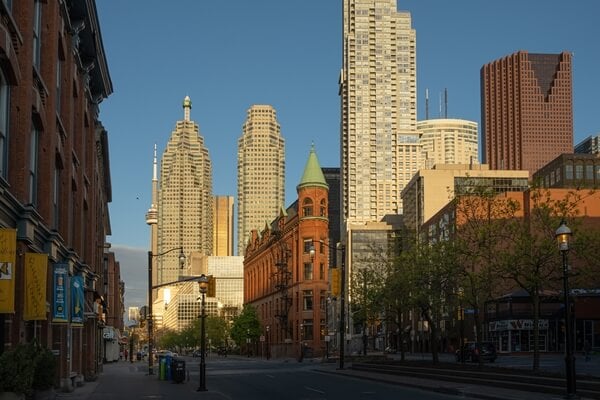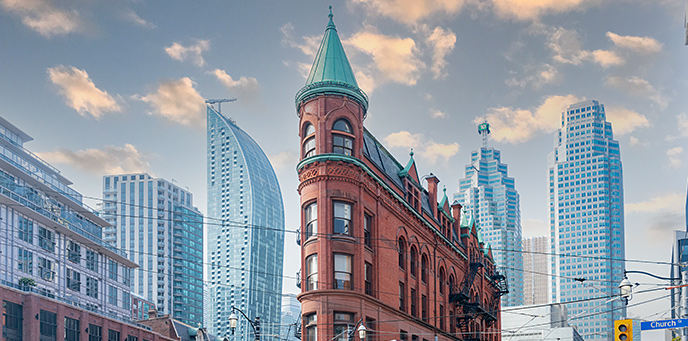Location Details: How Weather and Close-by Spots Can Enhance Your Trip.}
Location Details: How Weather and Close-by Spots Can Enhance Your Trip.}
Blog Article
Uncover the Rich Background Behind the Gooderham Structure in Toronto
The Gooderham Structure, an excellent symptom of Richardsonian Romanesque design in Toronto, has a storied past that extends past its striking red brick façade. Appointed by the prominent Gooderham and Worts distillery in 1891, this structure has actually played a pivotal role in forming the urban landscape of the St. Lawrence Market location.

Origins of the Gooderham Structure
Building a long-term heritage, the Gooderham Structure, also understood as the Flatiron Structure, arised as a sign of Toronto's architectural development in the late 19th century. The building's beginnings map back to 1891 when it was commissioned by the Gooderham and Worts distillery, among copyright's biggest distilling firms. Designed by designer David Roberts Jr. Gooderham Building address., the framework was uniquely positioned at the junction of Front and Wellington Streets, benefiting from a triangular whole lot produced by the convergence of these thoroughfares
The structure's building used regional red brick and terracotta, establishing an unique aesthetic that complemented the blossoming cityscape. Initially planned to house the Gooderham and Worts workplaces, the structure represented the success of the distillery, which had become a significant contributor to Toronto's economy. Significantly, the completion of the Gooderham Structure coincided with a period of quick urbanization that characterized the period.
The facility of this architectural treasure not only showcased cutting-edge design but additionally prepared for future advancements in Toronto. Today, it stands as a testament to the city's rich background and versatility, proceeding to draw in visitors and admirers from around the globe.
Architectural Value
The architectural significance of the Gooderham Structure prolongs beyond its distinctive flatiron shape, mirroring the ingenious spirit of late 19th-century layout. Finished in 1892, the structure exemplifies the Richardsonian Romanesque style, identified by its robust stonework, rounded arches, and intricate describing. The vibrant usage of contrasting materials, especially the warm red brick and sedimentary rock accents, enhances its visual appeal and demonstrates the workmanship of the period.
The structure's three-story design is notable for its unified percentages and stylish cornice, which add to its renowned silhouette against the Toronto sky line. The slim lot on which it stands positioned distinct challenges, yet the architects, in this situation, developed a framework that made best use of the readily available area while maintaining aesthetic equilibrium.
In Addition, the Gooderham Building is a testament to the flexibility of architectural style in city environments. Its long-lasting visibility among contemporary advancements highlights the worth of protecting historical design as a method of honoring a city's past. Today, it remains a cherished spots, reflecting both the building trends of its time and the evolving story of Toronto as a vibrant urban facility.
Role in Toronto's Development
Emerging as a key gamer in Toronto's metropolitan landscape, the Gooderham Structure added considerably to the city's growth during the late 19th century. The building was initially designed to offer as a storehouse for the Gooderham and Worts distillery, which was one of the biggest distilleries in the British Realm.
As the city expanded, the Gooderham Structure became an important component of the St. Lawrence Market location, which was a center of trade and commerce. Its special building style and famous visibility drew attention, affecting the style of succeeding structures in the vicinity. Moreover, the structure's survival via various financial changes and urban developments reflects the resilience and flexibility of Toronto's historic landscape. In significance, the Gooderham Building is not simply a building landmark; it played an essential role fit Toronto's identity and financial development throughout a transformative duration in its background.
Cultural Impact and Heritage
Gooderham Building's distinctive building style and historic value have actually left an indelible mark on Toronto's cultural landscape. As one of the city's most identifiable sites, its unique flatiron shape and detailed brickwork exhibit the Victorian building fads of the late 19th century. This structure not only functions as a visual support in the St. Lawrence neighborhood but additionally symbolizes the spirit of a burgeoning city during an era of financial development.
The structure has ended up being a sign of Toronto's abundant history, inspiring local artists and photographers who seek to capture its beauty. Its presence has actually cultivated a sense of area identity, adding to the narrative of city development. Moreover, the Gooderham Building has played an essential role in the tourism industry, bring in visitors eager to explore its fabled past and building elegance.
In addition to its visual charm, the structure encapsulates a story of resilience and adaptation, as it has transitioned through numerous uses over the years - Gooderham Building address. Therefore, the Gooderham Building stands not just as a monument of architectural importance however additionally as a testament to the evolving cultural heritage of Toronto

Reconstruction and Preservation Efforts
Many restoration and conservation initiatives have actually been taken on to ensure the Gooderham Structure stays an essential component of Toronto's architectural heritage. Initially completed in 1892, the building has undertaken substantial remodellings to resolve structural problems while keeping its historic integrity. The most notable repair happened in the late 20th century when the structure was meticulously refurbished to meet modern-day safety and security requirements without endangering its initial style aspects.
These initiatives consisted of fixing the unique red-brick façade, recovering the famous triangular form, and preserving the complex masonry details. Additionally, the building's interior has actually seen mindful updates that respect its historical importance, making certain that initial features such as wood beams and ornamental moldings are preserved.
The Gooderham Structure is currently shielded as an assigned heritage residential or commercial imp source property under the Ontario Heritage Act, which helps safeguard it from inappropriate modifications. Neighborhood engagement has played a vital function in these conservation initiatives, with local advocacy groups raising understanding concerning the building's historic significance. Therefore, the Gooderham Structure stands not just as a practical room but likewise as a testament to Toronto's rich architectural history and enduring cultural heritage.
Final Thought

Please visit one of our local supporters - Gamerama And The Repair Store - Toronto Iphone Repair
Report this page